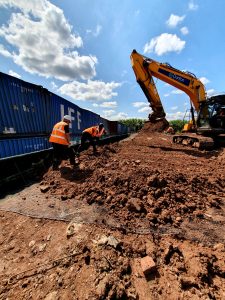Geosynthetics: Contain and compact
27 OCTOBER, 2021 BY NIA KAJASTIE
A West Midlands housing scheme required a visual and acoustic bund to screen new homes from nearby industrial activity. The construction of the bund involved geosynthetics and contaminated material.
A new housing development is taking shape close to Coventry city centre. Persimmon Homes’ Paragon Park incorporates 700 new dwellings on the site of a former brickworks in an area that has been earmarked for regeneration for many years.
The housebuilder was finally granted planning permission for the development in 2015.
As one of the planning conditions Persimmon agreed to build a visual and acoustic bund to separate the homes from a neighbouring metal recycling facility.
To fulfill this requirement, the scheme’s ground remediation specialist Dunton Environmental enlisted the help of geosynthetic solution provider Geosynthetics in early 2019.
Specialist geotechnical consultant Geoman was appointed independent checker for the structure.
The basic geometry of the bund was also set out in the site’s planning conditions which require a 9.5m high, 450m long, 80,000m3 bund with a 2m fence on top to hide the adjacent scrap metal merchant from Persimmon’s new houses.
Dunton considered several design options to achieve this within its budget, settling on Geosynthetics’ system of a geogrid reinforced slope with a 70° face angle on the external face and a 1 in 2 slope on the internal face.
Imported fill
A crucial part of creating the bund was achieving the sustainability credentials and commercial viability requirements set for the project. These dictated that the bund would be constructed from imported fill.
“Wherever possible, Geosynthetics will look to reuse site won fill within reinforced soil structures as this provides significant sustainability, commercial and programme benefits to our clients,” says Geosynthetics technical manager Eddie Emblen.
“The decision to use contaminated fill imported under licence for the bund at this project was quite unusual but fitted with Dunton’s expertise in processing such a material, and was key to this element of the overall site being commercially viable and meeting its sustainability targets,” he adds.
The fill was contaminated with hydrocarbons and heavy metals, and had to be treated and graded on site before it could be reused in the bund.

The scheme’s ground remediation specialist Dunton was assisted by Geosynthetics
Dunton Environmental divisional director James Hill adds: “The import and treatment of soils arising from the local construction sector was managed in accordance with the Development Industry Code of Practice and an environmental permit that promoted the sustainable use of waste soils. Site specific hazard and environmental risk assessment ensured that reusable soils did not pose a threat to the environment of future users of the site.”
As the fill for the bund was imported from a variety of sites, Geosynthetics and Geoman requested that Dunton carry out additional soil testing to verify that it met the parameters of a Class 2A/2C, dry cohesive material/stoney cohesive material, and Phi’ = 30 angle of internal friction, as used in the testing calculations.
The testing regime comprised particle size distribution and shearbox tests.
Emblen explains that after the fill had been placed and compacted, nuclear density and plate bearing tests were undertaken to ensure that a minimum California Bearing Ratio (CBR) of 15%, a minimum 95% of standard proctor density, and a maximum moisture content of 10% had been achieved.
“From the design point of view, establishing the correct design parameters for the imported fill for the bund as, unlike our products which we fully understand, this was a big, 80,000m3, unknown element that was outside of our control,” says Emblen.
Hill adds: “Our biggest challenge with the operation was ensuring the material was geotechnically suitable for the construction of the bund; this required us to ensure the correct treatment process was implemented, whether this was screening to remove oversize material or blending to create the ideal material for the construction.
“The weather played a large part in the construction, with rain affecting the moisture of the material and therefore compaction. Material management was a large part in ensuring the material was suitable
for reuse.”
During the very wet winter of 2019/20 heavy rain brought construction to a halt with work restarting in May/June 2020.
Bund geometry
Geosynthetics’ engineering department analysed the bund’s geometry, the imposed loads and the imported fill’s anticipated design parameters to prepare a technical recommendation for the scheme.
The engineers undertook stability analysis in accordance with BS8006:2010 and BSEN1997-1:2004 – Eurocode 7 to design the geogrid-reinforced soil bund with a design life of 60 years.
“From reviewing the site investigation report, it was originally thought that the underlying strata would be unable to support the bund without an engineered platform containing reinforcing layers of a high strength PET woven geotextile,” Emblen says.
However, further discussion with Dunton Environmental determined that its earthworks operation, placing compacted remediated material to raise the level to the required formation, could itself achieve the required bearing capacity for the bund.
Emblen says that having gone through a value engineering process, its final solution was the most cost effective in terms of the geosynthetic elements within the bund.
The solution used two grades of Stratagrid uniaxial geogrid (SGi40 and SGi60) at vertical spacings of 300mm to 600mm, with reinforcing tail lengths varying between 4.7m and 7.1m. The face of the slope consisted of a Geosynthetics Rivel Mesh system to ensure the required face geometry was achieved, with Landlok 450 for erosion control and to promote vegetation establishment.
Construction of the bund was split into three phases, with work starting in July 2019. The first phase was completed in November 2020, followed by the recent completion of phases two and three.
Article found at https://www.geplus.co.uk/features/geosynthetics-contain-and-compact-27-10-2021/

